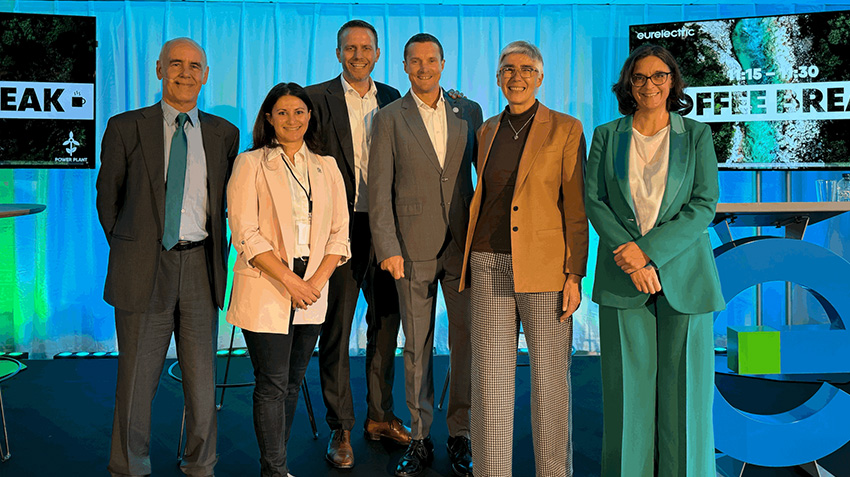Why biodiversity still matters – Power Plant 2.0

Last week Eurelectric launched Power Plant 2.0: an innovative guidebook designed to weave biodiversity into the fabric of grid and renewable energy projects. Crafted by WSP, this first-of-its-kind report outlines 12 actionable principles and real-life case studies for sustainable energy development. This guidebook showcases the commitment of the power sector to tackling climate change and biodiversity loss in synchrony rather in silos at a time when biodiversity has fallen from the top of policymakers’ agenda.
Biodiversity (vs.?) industrial competitiveness and energy security
Under the shadow of the recent EU elections, there is a growing focus on industrial competitiveness and energy security, often sidelining nature protection as a result. The high-level panel kickstarting Eurelectric’s launch event emphasised the urgency of protecting biodiversity within the EU’s evolving political landscape and the need to find a balance between advancing industrial and energy security goals and preserving natural ecosystems.
‘The prioritising of climate should not come at the expense of nature’, – stresses Humberto Delgado Rosa, Director for Biodiversity at the European Commission’s DG Environment. ‘In fact, nature is one of the best tools in the fight against climate change’.
Tina Sersen, State Secretary at Slovenia's Ministry of the Environment, Climate & Energy, reiterates this message, highlighting Slovenia's struggle to balance climate action with nature conservation.
“Today, the European Commission states that 40% of Slovenia’s land is under environmental protection. Thisoften scares away potential investments.” – said Seršen.
A balanced approach to combatting the negative effects of climate change while not compromising biodiversity should be prioritised. Despite all this, the country remains committed to its ambitious target of achieving 50% of renewables in its energy mix. For biodiversity and decarbonisation to work ubiquitously and together within the European borders, Seršen advocates for ‘finding common standards and common approaches’, stressing the need for a balanced strategy that supports both environmental and economic goals.
The Cost of Inaction is extinction
Understanding the urgency of the situation means understanding the devastating consequences civilisation faces if neither climate change nor biodiversity are adequately addressed. Jutta Paulus, a newly re-elected member of European Parliament, starkly warns:
‘A loss of biodiversity and a climate crisis could lead to de-civilisation. Going extinct is the most final thing you can do on this planet.’
Paulus stresses the need to acknowledge scientific facts as the first step towards tackling these interconnected crises. Her call is echoed by Noor Yafai, Europe Director at the Nature Conservancy, who highlighted the urgency for policymakers to recognise the mutual benefits of collaboration between industry and civil society
‘Politicians need to begin seeing the win-wins of collaboration. There is no time to waste, a great sense of urgency must be felt,’ – asserted Yafai.
Challenges and Solutions
While the urgency of the situation was palpable throughout the discussion, the path forward presents significant challenges. Bruce Douglas, Executive Officer of Global Renewables Alliances emphasises the scale of the challenge ahead. To meet the COP28 goal of tripling renewable energy by 2030, an additional, 3000 megawatts per day will need to be added. To achieve such a massive deployment:
“We must electrify everything that can be electrified and I now add I harmony with nature” – stated Douglas.
Another challenges often mentioned throughout the event was the lack of harmonised metric and methodologies for biodiversity as well as a financing gap. Delgado Rosa stressed the critical role of private financing to complement public funding for scaling up nature inclusive practices.
Seršen, on the other hand, proposed creating a European list of bird species not threatened by solar farms to streamline the approval process for renewable energy projects. Both Seršen and Delgado agreed on the importance of standardising policies across EU member states to facilitate smoother implementation of biodiversity-friendly practices.
Paulus addressed the contentious issue of land use, particularly the impact of rising sea levels on finite land resources, stating, ‘Finding land efficiency will be necessary’. She goes on to point out that agriculture is the biggest use of land in the EU. Her solution is to ensure policymakers find effective tools and ways to calm the political debate on land use as well as treat farmers fairly,
‘Farmers are not the problem; they are pro-nature, but they are opposed to regulations that threaten their bottom line,’ Paulus explains.
The potential for pragmatic solutions and effective awareness raising communication emerged as the way forward, with Douglas passionately calling for improved communication to combat disinformation from the oil and gas sector. Kristian Ruby, Secretary General of Eurelectric, advocated for a pragmatic approach to scaling supply chains for the industry to keep decarbonising, while ensuring that these efforts are balanced with environmental protection measure.
At the same time, Ruby cautioned against the pitfalls of overly detailed regulations that could stifle progress
– ‘We must make sure that we do not drown in rules,’ – he warns, ‘non-price criteria could become too detailed and slow the process down’.
A recurring theme throughout the discussions was the importance of avoiding a polarised debate between nature and renewables. Panellists all agreed – a collaborative and balances approach is essential to move forward effectively.
Biodiversity must remain a priority
Despite Europe’s challenges with the demands of industrial competitiveness and energy security, nature conservation must remain at the top, it must remain integral to every stage of development. By fostering collaboration and embracing innovative solutions, Europe can achieve this delicate yet sustainable balance. By integrating biodiversity preservation with green energy goals, the EU can ensure that progress and nature protection go hand in hand.
Power Plant 2.0 showed that the future of biodiversity and human progress are not mutually exclusive. With dedicated effort and innovative thinking, a harmonious coexistence is not only possible, but well within reach.
